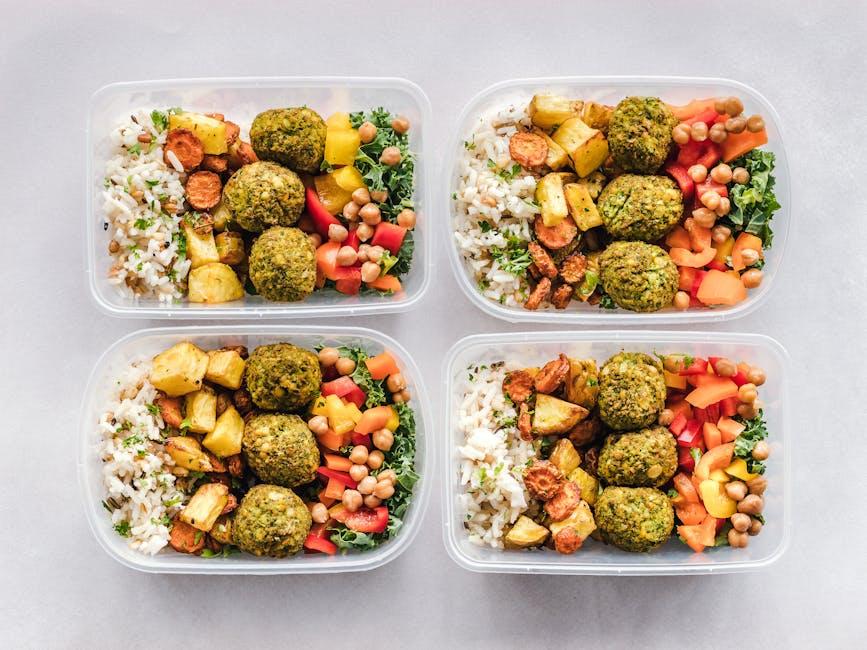Table of Contents
- Understanding Your Monthly Food Budget Breakdown
- Smart Grocery Shopping Tips for Maximizing Savings
- Meal Planning Strategies to Stretch Your Dollars
- Nutrient-Dense Choices That Wont Break the Bank
- Creative Cooking Techniques for Budget-Friendly Meals
- Q&A
- Key Takeaways


Understanding Your Monthly Food Budget Breakdown
When planning your monthly food expenditures, it’s crucial to have a clear breakdown of where your money goes. Start by identifying your primary categories. Each category can contribute significantly to your overall food spending. Here are some common areas to consider:
- Groceries: This is often the largest portion of your food budget. Focus on fresh produce, pantry staples, and proteins.
- Dining Out: Allocate funds for restaurants, cafes, and quick bites, which can quickly add up if not monitored.
- Snacks and Beverages: Don’t overlook this category; it can take a significant chunk of your budget if you enjoy treats or specialty drinks.
After determining your categories, track your spending in each area. This will help you stay within budget and make adjustments as needed. Consider organizing your budget in a table format for clarity:
| Category | Budgeted Amount | Actual Spending |
|---|---|---|
| Groceries | $300 | ___ |
| Dining Out | $150 | ___ |
| Snacks/Beverages | $50 | ___ |
analyzing your spending habits over time enables you to make informed decisions and optimizations. Consider reviewing your monthly totals to identify patterns or excess spending. Strengthening your understanding of these figures will not only help you stick to your budget but also allow for smart substitutions. For example, if you notice you’re consistently overspending on dining out, simply adjusting your grocery budget can free up cash to indulge occasionally without a financial hangover.


Smart Grocery Shopping Tips for Maximizing Savings
To stretch your food budget, start by establishing a clear grocery list before you head to the store. Planning meals for the week can help you avoid impulse buys and unnecessary purchases. Here are a few ways to create an effective shopping list:
- Check your pantry and fridge for existing items to use.
- Incorporate versatile ingredients that can be used across multiple meals.
- Stick to your list to minimize temptation and reduce spending.
Another crucial aspect of smart grocery shopping is timing your visits. Shopping during off-peak hours or on certain days can lead to better deals and markdowns. Many grocery stores have weekly flyers showcasing special offers, so staying informed can lead to substantial savings. Consider these tips:
- Shop early in the day or late at night for fresh markdowns.
- Visit local markets towards the end of the day for discounted produce.
- Look out for seasonal sales and promotions to maximize savings.
don’t underestimate the power of comparison shopping. Utilize online tools or apps that allow you to compare prices across stores in your area. This can guide you to the best deals available. Keep an eye out for store brand products, which often offer quality comparable to name brands at a lower price. Here’s how you can optimize your savings:
- Track price history for your favorite items to purchase at the best time.
- Sign up for loyalty programs to receive exclusive discounts and coupons.
- Consider bulk buying non-perishable items for long-term savings.


Meal Planning Strategies to Stretch Your Dollars
Meal planning is a powerful way to maximize your groceries without overspending. Start by assessing what you already have in your pantry and refrigerator. This not only prevents waste but also allows you to build meals around these staples. Create a theme for each day (i.e., Meatless Mondays, Taco Tuesdays) to streamline your grocery shopping and diversify your meals. A consistent theme helps make weekly planning easier and ensures you enjoy a variety of foods without exceeding your budget.
Next, consider making a detailed shopping list based on your meal plan. Stick to the list to avoid impulse buys, which can significantly impact your overall spending. Focus on buying in bulk for non-perishables and choose seasonal produce to keep costs low. Incorporating ingredients across multiple meals can also enhance your budgeting efforts. For example, using spinach in a salad, a smoothie, and a pasta dish throughout the week helps ensure that nothing goes to waste.
| Ingredient | Meals | Budget-Friendly Tip |
|---|---|---|
| Brown Rice | Stir-Fry, Rice Bowl, Soup | Buy in bulk for the best price. |
| Chicken Thighs | Grilled, Tacos, Curry | Purchase family packs and freeze portions. |
| Canned Beans | Chili, Salad, Burritos | Choose store brands to save more. |
allocate one day a week for meal prep. Cooking in batches not only saves time but also ensures you make the most of your ingredients. Additionally, consider freezing leftovers for future meals, which can be a lifesaver on busy days. Taking these steps allows for flexibility and creativity while keeping your food budget in check.


Nutrient-Dense Choices That Wont Break the Bank
When shopping on a budget, the key is to seek out ingredients that pack a nutritional punch without causing sticker shock. Legumes such as lentils, beans, and chickpeas are not only affordable but also provide a whopping dose of protein and fiber. Utilizing these in your meals can stretch your dollar while keeping your meals satisfying. Consider integrating these options into your weekly meal plan through:
- Soup and stew bases
- Salads
- Veggie burgers
Another excellent way to get more nutrition for less money is by incorporating seasonal fruits and vegetables. Purchasing produce that is in season not only enhances flavor but also lowers costs. A simple trip to your local farmer’s market may reveal bundles of fresh produce at unbeatable prices. Some great seasonal picks include:
- Carrots
- Spinach
- Apples
Don’t overlook whole grains, which are crucial for a balanced diet. Grains like brown rice, quinoa, and barley are typically budget-friendly staples that can serve as a foundation for many meals. By choosing whole grains, you’re opting for higher nutritional value while simultaneously keeping costs low. Here’s a quick comparison of basic grains, including cooking time and cost:
| Grain Type | Cooking Time | Approximate Cost (per cup) |
|---|---|---|
| Brown Rice | 45 minutes | $0.50 |
| Quinoa | 15 minutes | $1.00 |
| Barley | 45 minutes | $0.40 |


Creative Cooking Techniques for Budget-Friendly Meals
Exploring new cooking techniques can be a game changer when it comes to keeping your food budget under control. One effective method is meal prepping, a practice that involves planning and preparing your meals for the week ahead. By dedicating just a few hours on the weekend, you can cook large batches of your favorite dishes, portion them out, and store them in your refrigerator or freezer. This not only saves money but also drastically reduces the temptation to order takeout during busy weekdays.
Another innovative approach is one-pot cooking, which simplifies both the cooking process and clean-up. You can create a variety of flavorful meals using just a single pot or pan, such as stir-fries, casseroles, or soups. This method allows you to utilize leftover ingredients and pantry staples effectively, keeping your meals diverse while minimizing waste. Here are some essential one-pot meal ideas to consider:
- Vegetable and lentil stew
- Chicken and rice with seasonal veggies
- Pasta with tomato sauce and mixed greens
embracing finite cooking techniques like cooking in bulk or utilizing lesser-known cuts of meat can stretch your dollar further. For instance, opting for a whole chicken allows you to roast it for dinner and then use the leftovers for sandwiches or salads throughout the week. Consider using the following table to guide your budget-friendly protein options:
| Protein Source | Average Cost per Pound | Meal Ideas |
|---|---|---|
| Whole Chicken | $1.50 | Roast dinner, shredded for tacos |
| Ground Turkey | $3.00 | Meatballs, stir-fry, tacos |
| Dry Beans | $1.00 | Chili, salads, soups |
Q&A
Q&A: Understanding Food Budgets
Q1: What is a food budget, and why is it important? A: A food budget is a financial plan that allocates a specific amount of money for groceries and meals over a defined period, typically monthly. It’s important because it helps you track your food expenses, manage your finances better, reduce food waste, and ensure you’re eating healthily without overspending.Q2: How can I create an effective food budget? A: Start by evaluating your monthly income and necessary expenses. Next, determine how much you can comfortably allocate to food. Track your current spending on groceries and dining out for a month to understand your habits. create a spending plan that includes grocery shopping, dining out, and meal prep, adjusting as needed based on your findings.
Q3: Can you provide an example of a food budget for a family of four? A: Certainly! Here’s a basic monthly food budget for a family of four:
- Groceries: $600
- Dining Out: $200
Q4: How can I stick to my food budget? A: To stay within your budget, plan meals ahead, create shopping lists, and stick to them to avoid impulse purchases. Buy in bulk when possible, use coupons, and consider purchasing seasonal produce for better prices. Preparing meals at home rather than dining out can also significantly reduce costs.
Q5: What are some tips for saving money on groceries? A: Here are a few effective tips to save money:
- Plan Meals: Set a weekly meal plan to minimize waste and maximize efficiency.
- Shop Sales: Keep an eye on weekly ads and plan your shopping trips around sales.
- Cook in Batches: Prepare large portions and freeze extras to save time and avoid waste.
- Farmers’ Markets: Buy fresh produce directly from local farmers for competitive prices.
- Generic Brands: Opt for store-brand products, which often offer quality similar to name brands at a lower cost.
Q6: How can I adjust my food budget if my financial situation changes? A: If your financial situation changes, revisit your food budget immediately. Look for areas where you can cut back—whether it’s reducing dining out frequency, opting for less expensive grocery items, or investigating local food assistance programs. Remember, flexibility is key; adjust your allocations based on your current circumstances.
Q7: What are some healthy eating options within a budget? A: Healthy eating doesn’t have to be expensive. Prioritize:
- Whole grains (brown rice, quinoa) over processed grains.
- Seasonal fruits and vegetables, which are cheaper and fresher.
- Legumes (beans, lentils) as protein sources, which are both nutritious and budget-friendly.
- Frozen fruits and veggies, often just as nutritious as fresh and longer-lasting.




0 Comments